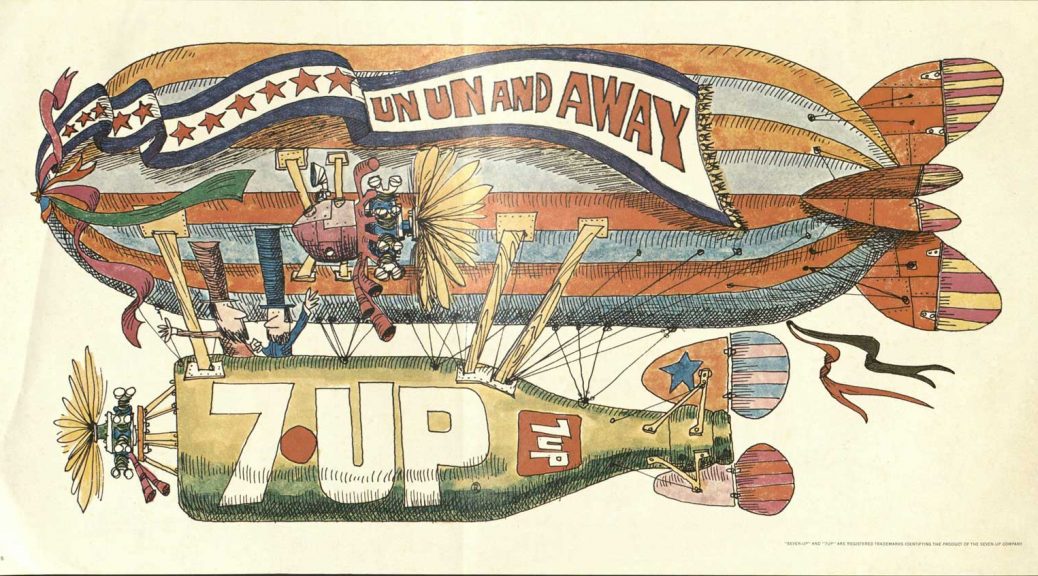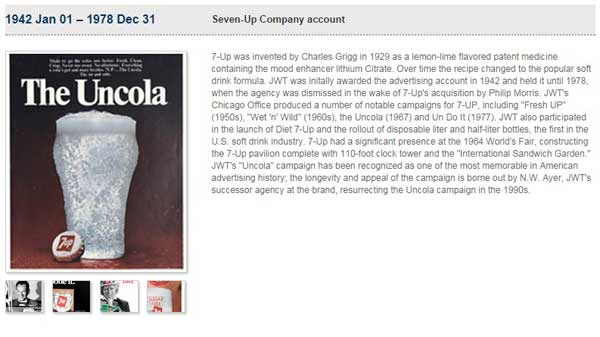Post contributed by Claire Payton, John W. Hartman Center for Sales, Advertising & Marketing History intern and Ph.D. candidate, Duke University Department of History
It was 1967, and people weren’t drinking Seven-Up. Well, a few were: consumers mostly thought of the bubbly beverage as a mixer or a tonic to calm an upset stomach. But executives at the St. Louis-based Seven-Up Company were anxious to tap into a wider market. The company wanted to rebrand its product as a common soft-drink like the more well-known cola beverages, Pepsi or Coca-Cola. It enlisted a marketing team from the Chicago office of the J. Walter Thompson ad agency to help them. Out of this collaboration came one of the most famous advertising campaigns of the 20th century.
The late 1960s were a difficult time in America. The Vietnam War and the fight for civil rights divided the country. Disillusioned young people were building a robust oppositional counter-culture that rejected war, racial segregation, and violence. The summer of 1967 became known as the “Summer of Love,” a period when hippies gathered in San Francisco and cities around the country in the hopes of igniting “a renaissance of compassion, awareness, and love, and the revelation of unity for all mankind.”
Seizing on this oppositional energy, the JWT team designed a campaign that framed 7-Up as the ultimate oppositional drink: the “Uncola.” Rather than trying to play up the similarities the soda shared with its competitors, the new ads focused on its differences. In the company newsletter, the team explained “Seven-Up advertising tells people that, of the three top-selling soft drink brands, 7-Up, the Uncola, is the only one with distinctly different qualities.”
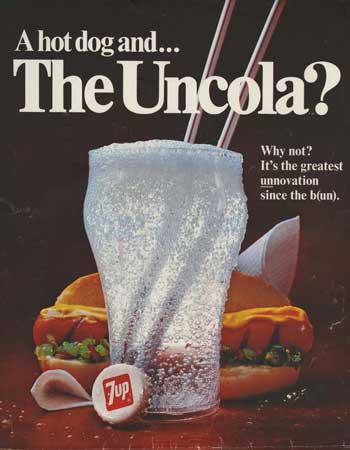 The “Uncola” struck a chord with the younger generation as the first ads appeared in 1968. They focused on puns based around “un” part of the new slogan. By portraying Coke and Pepsi as “the Establishment,” JWT effectively situated 7-Up as an alternative brand for alternative people.
The “Uncola” struck a chord with the younger generation as the first ads appeared in 1968. They focused on puns based around “un” part of the new slogan. By portraying Coke and Pepsi as “the Establishment,” JWT effectively situated 7-Up as an alternative brand for alternative people.
The following year JWT created a contest inviting artists to submit wildly imaginative designs for 7-Up ads. The submissions were presented to the client, who chose the final images. The winner received a $2000 reward and the opportunity to work with JWT to make final versions. From this contest, JWT and the Seven-Up company built a campaign of colorful road-side billboards with psychedelic graphics. Art by young graphic designers including Pat Dypold, Ed Georges, and Milton Glaser dotted highways across the country in 1969.
A 1973 article from Southern Advertising described the success of the billboard campaign: “To zero in on the college and younger age groups, [Seven-Up executive] Roesch has developed a different approach to the use of the outdoor medium. The agency’s media department uses outdoor as a means of zeroing in on a specific target . . . instead of as a mass media that doesn’t discriminate. The boards are located accordingly, and the art used is slated to the specific likes of the age groups. The result has been demand for Seven-Up posters to be used as room decorations, party decorations, all without any promotion by the company.”
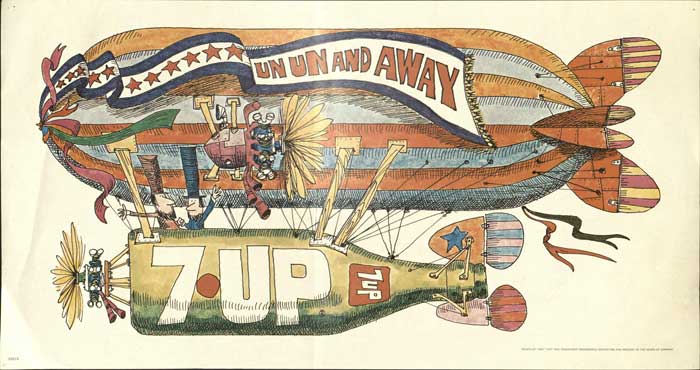
The campaign complemented its print ads and billboards with television spots. The most memorable ads from this campaign featured Trinidadian dancer and actor Geoffrey Holder explaining the difference between ugly, dry, kola nuts and the tangy, juicy lemon and limes that flavor 7-Up. The ad broke racial barriers within the Seven-Up Company, which until then had never used black actors in its television ads.
The Uncola campaign continued into the 1970s. As times changed, the campaign tried to stay in dialog with oppositional culture by incorporating new visual mediums such as grafitti. JWT argued that “In 1968, the rebellious approach of youth was a workable parallel for the rebellious approach of Seven-Up. Today, in the Seventies, the attack remains viable.” However, 7-Up’s hard-won market share declined over the course of the decade, losing ground to the growing popularity of another lemon-lime soda, Sprite.
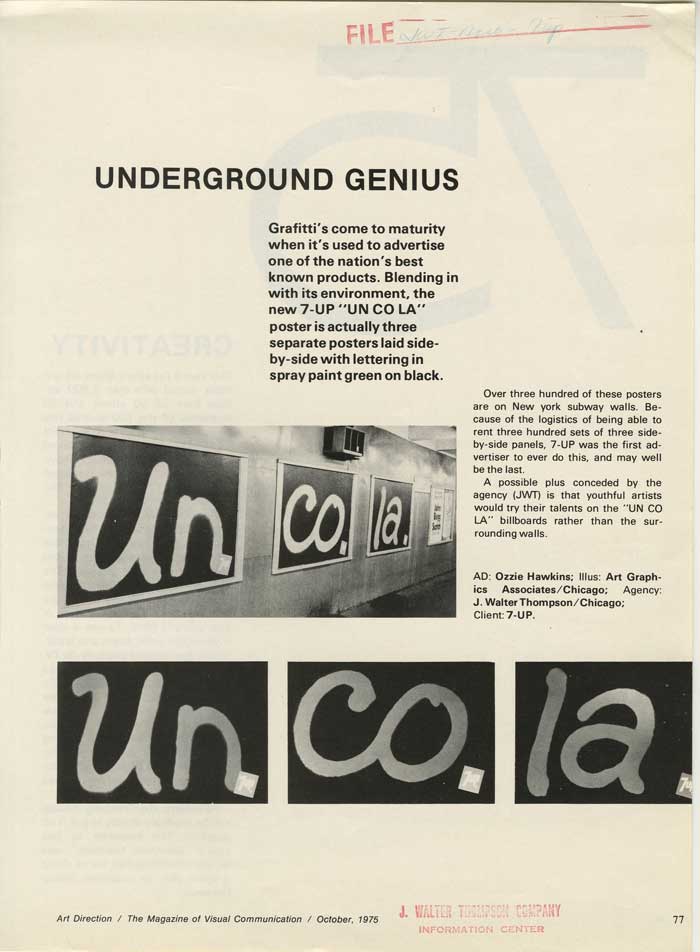
Perhaps the soda became a victim of its own success. The Uncola campaign had so effectively linked to the youth of the 1960s that by the 1990s, it was considered ”what old people drink,” in the words of one financial analyst, “and that’s not what you want in a soft drink.” In 1998, the company finally dropped the Uncola slogan and reinvented its formula. Since then the company has since tried several different campaigns to redefine its identity without success. Regardless, the Uncola campaign will remain a mainstay of the consumer culture of 20th century America and a sign of the times in which it was created.


